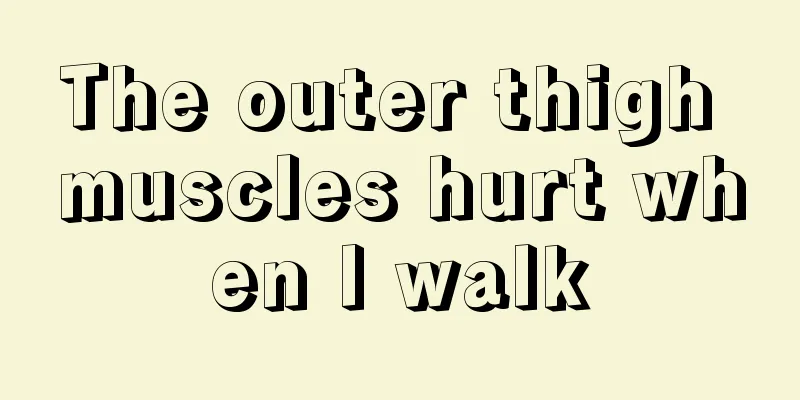The outer thigh muscles hurt when I walk

|
Pain in the outer thigh muscles when walking not only affects the beauty of walking posture, but also affects health and pain. There are many reasons for this situation, such as strenuous exercise, excessive fatigue, sprains, strains, inflammatory stimulation, mental pressure, and even lumbar disease. Next, let us take a closer look at some of the factors that cause this situation and effective relief and treatment measures. Everyone must carefully understand them in detail so that targeted treatment can be provided. There is a high possibility of lumbar disc herniation. It is recommended that you go to the hospital for diagnosis and symptomatic treatment. Lumbar disc herniation is one of the more common diseases. It is mainly caused by different degrees of degenerative changes in the various parts of the lumbar disc (nucleus pulposus, annulus fibrosus and cartilage plate), especially the nucleus pulposus. Under the influence of external factors, the annulus fibrosus of the intervertebral disc ruptures, and the nucleus pulposus tissue protrudes (or falls out) from the rupture to the back or inside the spinal canal, causing the adjacent spinal nerve roots to be stimulated or compressed, resulting in a series of clinical symptoms such as low back pain, numbness and pain in one or both lower limbs. The highest incidence of lumbar disc herniation is at L4-5 and L5-S1, accounting for about 95%. Clinical manifestations 1. Symptoms 1. Low back pain It is the first symptom that occurs in most patients, with an incidence of about 91%. Because the outer layer of the annulus fibrosus and the posterior longitudinal ligament are stimulated by the nucleus pulposus, induced pain in the lower back is produced through the vertebral nerve, sometimes accompanied by buttocks pain. 2. Radiating pain in the lower limbs Although high-level lumbar disc herniation (L2-3, L3-4) can cause femoral neuralgia, it is rare in clinical practice, accounting for less than 5%. The vast majority of patients have herniation between L4 and 5, or L5 and S1, and present with sciatica. Typical sciatica is pain that radiates from the lower back to the buttocks, back of the thigh, outer side of the calf to the foot. The pain is aggravated by increased abdominal pressure due to sneezing and coughing. The radiating pain is mostly on one side of the limbs, and only a very small number of patients with central or paracentral nucleus pulposus herniation show symptoms in both lower limbs. There are three causes of sciatica: ① The ruptured intervertebral disc produces chemical stimulation and autoimmune reactions, causing chemical inflammation of the nerve roots; ② The protruding nucleus pulposus compresses or stretches the inflamed nerve roots, blocking their venous return, further aggravating edema and increasing sensitivity to pain; ③ The compressed nerve roots are ischemic. The above three factors are interrelated and aggravate each other. 3. Cauda equina symptoms The nucleus pulposus protruding to the rear or the prolapsed and free intervertebral disc tissue compresses the cauda equina, which mainly manifests as difficulty in defecation and urination, and abnormal sensation in the perineum and perianal area. In severe cases, symptoms such as incontinence and incomplete paralysis of both lower limbs may occur, which are rare in clinical practice. prevention Lumbar disc herniation is caused by accumulated injuries based on degenerative changes, and the accumulated injuries will aggravate the degeneration of the intervertebral disc. Therefore, the focus of prevention is to reduce accumulated injuries. You should maintain a good sitting posture at ordinary times, and the bed should not be too soft when sleeping. People who work at a desk for a long time need to pay attention to the height of the table and chair and change their posture regularly. People who need to bend over frequently in their jobs should stretch their waists and chests regularly, and use a wide belt. The training of the waist and back muscles should be strengthened to increase the intrinsic stability of the spine. Those who use waist belts for a long time should pay special attention to the training of the waist and back muscles to prevent the adverse consequences of disuse muscle atrophy. If you need to bend over to pick up something, it is best to flex your hips and knees and squat to reduce pressure on the back of the lumbar disc. |
<<: Is foaming facial cleanser any good?
>>: Pain at the junction of thigh and pelvis
Recommend
Is it good to eat too much soy sauce?
Soy sauce is a common condiment and a must-have k...
Seasonal peeling_How to treat seasonal hand peeling
The symptom of seasonal peeling will automaticall...
What to do if you are allergic to decoration smells
Many people will decorate their new houses after ...
How many minutes does it take for a pregnancy test to give results?
Some women do not pay attention to some behaviors...
Is bromine oxide harmful to human body?
Bromine oxide, also known as ozone, can cause cer...
What does fish test for breast cancer mean and how to do it
FISH testing usually refers to fluorescence in si...
What causes early nasopharyngeal cancer
What causes early nasopharyngeal cancer? 1. Nasop...
What are the symptoms of cauliflower-type gastric cancer
Gastric cancer is a common disease in life, and i...
Can lychees and grapes be eaten together
Lychees and grapes are two different fruits, both...
What are the oral western medicines for skin cancer
What are the oral western medicines for skin canc...
What should I do if my knees are cold and painful
Knee pain caused by cold is actually something th...
What should I do if dizziness is caused by the spine?
Dizziness is a symptom that people often experien...
What to do if your frosted shoes get dirty?
Nowadays, many people like to wear matte shoes. W...
The old man's tongue blistered and he delayed for 2 months to find out that he had tongue cancer and had half of his tongue removed
The ulcer at the root of the tongue lasted for tw...
The pot at home is burnt and the smell is choking. How can I get rid of the smell?
Some people like to cook some dishes at home duri...









